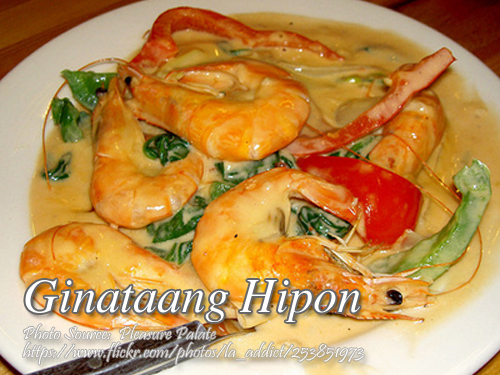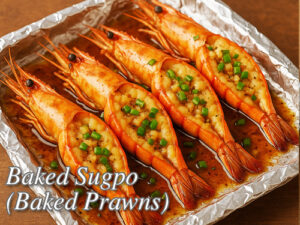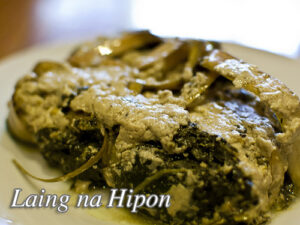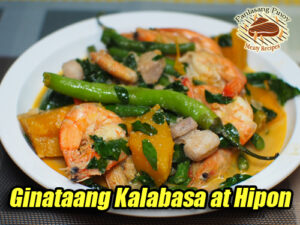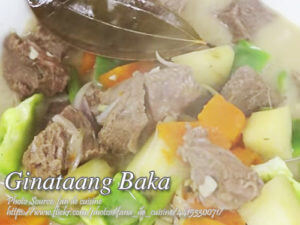This recipe is the cheaper version of ginataang sugpo or prawns in coconut milk. But even if it is not as expensive as the big prawns, ginataang hipon is almost as tasty as it’s counterpart. When buying shrimps choose the freshest and the biggest you can find. And with regard to coconut milk, the best one is buying fresh coconut cream that is sold in wet market already packed in small plastic bags. Just make sure the coconut cream is pure and not diluted with water. Some vendors are sneaky by diluting it with water. Anyway you will also dilute the coconut cream with water to make coconut milk and I think 1:1 ratio is okay. For example, in cup coconut cream, dilute it with 1 cup of water.
You can also extract the coconut cream and coconut milk yourself if you bought grated mature coconuts but that is tedious. Just remember, the first extraction is the coconut cream. The second extraction is the coconut milk which you have to put water on the grated coconuts before squeezing it to get the milk. The easiest is buying coconut milk and coconut cream in cans but it is not as flavorful as the fresh one.
Ginataang Hipon: A Taste of Home in Every Bite
Growing up, ginataang hipon was a dish that often graced our family table during special Sunday lunches. My mom, Aling Marita, swore by her mother’s recipe, and she always told us how this was the “budget-friendly cousin” of the more lavish ginataang sugpo. Back then, we didn’t mind the absence of large prawns because the dish’s creamy coconut sauce made everything taste so indulgent. The aroma of simmering coconut milk mixed with the delicate sweetness of fresh shrimp always drew us to the kitchen, eagerly waiting for the meal to be served.
Choosing Fresh Shrimps for Ginataang Hipon
One of the secrets my Uncle Lando shared with me is that the flavor relies heavily on the freshness of the shrimp. He always joked, “Walang magandang luto kung panis ang hipon!” Whenever he bought seafood at the local palengke, he would inspect each shrimp for its firm texture and slightly translucent shell. “If the head falls off too easily, it’s not fresh,” he’d add, a tip I’ve carried with me to this day.
Fresh shrimp gives the dish its natural sweetness, balancing perfectly with the richness of the coconut milk. If you’re lucky enough to live near a coastal province like my cousin Beth in Roxas City, you’re in for a treat because the shrimps there are plump and taste like the ocean itself.
Coconut Milk: The Soul of Ginataang Hipon
Coconut milk and cream are the heart and soul of this dish, and my Lola Sabel always insisted on using fresh ones. She had this knack for picking the right coconuts at the market, ones that were mature enough to yield a rich and creamy extract. I remember helping her grate the coconuts and squeeze out the first and second extractions to make both the cream and milk. It was labor-intensive, but it taught me how much love went into preparing our meals.
Nowadays, I usually buy freshly packed coconut cream from the wet market. However, if I’m short on time, I’ll grab canned coconut milk and cream. While not as flavorful as the fresh ones, a pinch of salt and an extra simmer can enhance the taste. The trick is to stir gently and cook the coconut cream long enough until it releases its natural oil. This step is essential because it deepens the flavor and gives the dish its signature glossy appearance.
Why Slow Simmering is Key
When I first tried cooking ginataang hipon on my own, I couldn’t understand why my mom always emphasized slow simmering. “Patience, anak,” she would say. “Good food takes time.” The secret lies in allowing the coconut milk to cook gently, blending the flavors of the shrimp and spices. Rapid boiling can curdle the milk, leaving you with an unpleasant texture, so slow and steady is the way to go.
As the mixture reduces, the flavors intensify, coating each shrimp in a creamy sauce that’s absolutely irresistible. My kuya Jojo once experimented by adding a bit of shrimp paste for an umami kick, and it worked wonders. But even in its simplest form, this dish never fails to impress.
The Role of Siling Haba and Other Additions
In our family, the siling haba is more than just a garnish; it’s a game-changer. It adds a subtle heat that elevates the dish without overpowering it. My sister, Carla, who lived in Bicol for a few years, shared her version where she added chopped ginger and a dash of vinegar to the coconut milk. “Para hindi nakakaumay,” she explained, and she was right. These little tweaks add depth to the dish, making each bite even more exciting.
For an added crunch and freshness, we sometimes top it with slices of cucumber and tomatoes, a tradition my mom picked up from her best friend, Tita Celia. It’s a small touch, but it brings a balance of texture and brightness to the creamy, savory dish.
A Dish with Deep Filipino Roots
Ginataang hipon, like many dishes cooked in coconut milk, has deep roots in Filipino culinary history. The use of gata, or coconut milk, traces back to pre-colonial times when our ancestors relied on coconut as a staple ingredient. Whether it’s used for savory stews, desserts, or beverages, coconut milk has always been a testament to our resourcefulness and love for bold, rich flavors.
In regions like Bicol, ginataang dishes are celebrated for their spice and creaminess. But even outside Bicol, ginataang hipon has found its way to the hearts of many Filipinos. It’s a dish that showcases the simplicity and richness of Filipino cooking, reminding us that even humble ingredients can create something truly extraordinary.
Bringing it All Together
Every time I cook the shrimp dish, I’m reminded of lazy Sundays spent with my family, the laughter echoing in the dining room as we passed around bowls of steaming rice and creamy shrimp. It’s more than just a dish; it’s a piece of home.
If you’re a beginner in the kitchen, don’t be intimidated by this recipe. Start with the freshest shrimp you can find and invest in good-quality coconut milk. Take your time simmering the sauce until it’s thick and luscious. Most importantly, cook with love because that’s what transforms simple ingredients into something truly special.
Ginataang hipon may not be as fancy as its prawn counterpart, but its flavor and nostalgia make it a dish worth savoring every time.
How to Cook Ginataang Hipon (Shrimp in Coconut Milk)
Ingredients
- 1/2 cup coconut milk
- 1/2 kilo fresh shrimps small, heads removed
- 3-4 pcs siling haba finger-like pepper to taste
- 1 tsp. salt
- 1/2 cup coconut cream
- 1 pc small cucumber sliced
- 1 pc whole tomato sliced
Instructions
How to cook Ginataang Hipon
- In a saucepan, combine coconut milk, shrimps, siling haba and salt.
- Simmer slowly until almost dry. Add coconut cream.
- Stir lightly under low heat until oil separates from the mixture.
- Serve hot topped with sliced cucumber and tomatoes. Serves 8.
Notes
Cooking Tips:
Choose Fresh Shrimps for the Best Flavor
Always select fresh shrimp with firm bodies and translucent shells to ensure a naturally sweet and flavorful dish. Avoid shrimp with a strong ammonia smell or loose heads, as these are signs of spoilage. Fresh shrimp enhances the overall taste of ginataang hipon, creating a more satisfying and authentic experience.Simmer Coconut Milk Slowly for a Creamy Sauce
Cooking the coconut milk over low heat allows it to blend seamlessly with the shrimp and spices, creating a velvety, rich sauce. Avoid rapid boiling, as this can cause the coconut milk to curdle, affecting the texture of the dish. Patience during this step ensures a smooth, flavorful sauce that perfectly complements the shrimp.Add Siling Haba for a Gentle Heat
Include siling haba to introduce a mild, aromatic spice that balances the richness of the coconut milk. Add the chili early in the cooking process to allow its flavors to infuse into the sauce without making the dish too spicy. This subtle heat elevates the overall taste, making every bite more vibrant and exciting.
